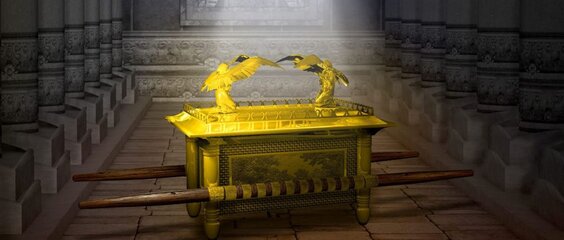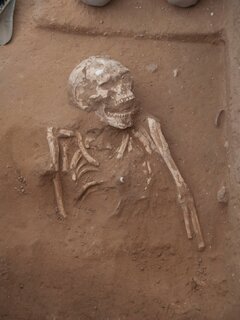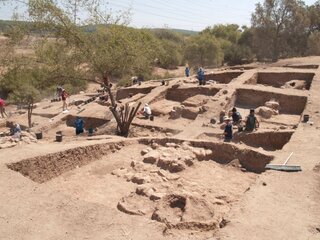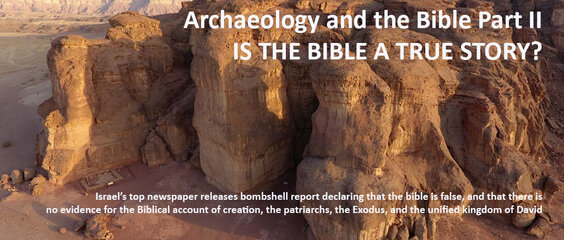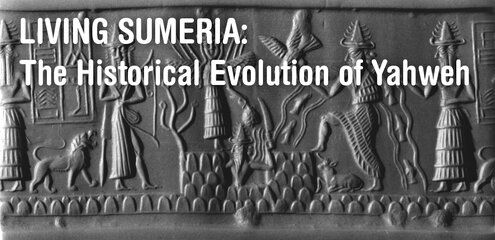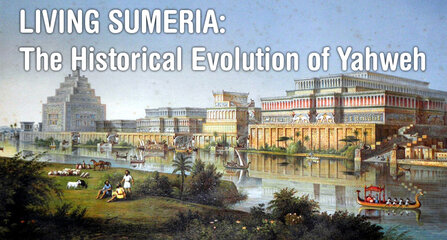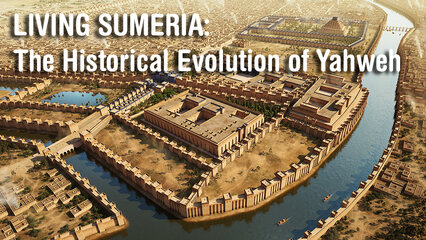Haaretz: The Real Ark of the Covenant May Have Housed Pagan Gods
The holy ark was likely kept in Jerusalem for much less time than the Bible tells us.
And it may have contained something other than the Ten Commandments
The last time the Ark of the Covenant was supposedly seen was in Jerusalem, some 2,600 years ago.
Now archaeologists are exploring the ancient town of Kiriath Jearim, where the Bible says the ark was kept for 20 years before being taken to Jerusalem. Even if the excavators don’t expect to find the ark itself, and they don't, they have made discoveries that shed new light on the history of the ancient Israelites and the birth of Judaism itself. Their finds also support theories that King David may not have been the one who moved the ark to Jerusalem.
According to the biblical tale, after the people of Israel bore the Ark of the Covenant through the desert and following Joshua’s conquest of Canaan, it was kept in the Tabernacle at Shiloh – and was then lost in a terrible battle to the Philistines. But God punished the Philistines with sickness and other plagues and they wisely returned their booty to the Israelites, who then settled the ark at Kiriath Jearim for 20 years.
Then, goes the story, King David took it to Jerusalem to be housed first in a tent, and later in King Solomon’s Temple.
From that point, until Jerusalem's destruction by the Babylonians, the ark strangely disappears from the biblical narrative. Nowhere does it figure in the exploits of the kings of Judah or Israel, points out Thomas Römer, a world-renowned expert in the Hebrew Bible and a professor at the College de France and the University of Lausanne.
Supernatural powers
That hasn't stopped scholars and archaeologists from seeking out any clue about its true history. Maybe the ark's enduring mystique lies in the fact that, according to the Bible, it contained the original stone tables of the Ten Commandments, and it had godly powers, which could rally the Israelite armies in battle or strike dead anyone who dared touch it or look inside it.
When they return daily to base camp, the archaeologists digging at Kiriath Jearim divide their finds into various baskets with labels like “glass,” “animal bones” or “small finds.” Just one basket remains inevitably empty: the one jokingly labeled “the ark.”
No, no one expects to find any trace of the elusive ark in the ruins of this ancient Israelite settlement.
“I am not interested in the historicity of the Ark Narrative. I want to know what’s behind it, what it tells us about the history of Judah and Israel, of the cult of the God of Israel and the Temple in Jerusalem,” says archaeologist Israel Finkelstein of Tel Aviv University, who has conducted digs at two locations said to have housed the ark: at Shiloh, north of Jerusalem, back in the 1980s, and this month at Kiriath Jearim, in a joint project with the College de France.
Not King David after all?
Many Biblical scholars think the story of the ark was a separate text, the so-called “Ark Narrative,” dating from around the 8th century B.C.E., which was later incorporated into the biblical texts, in the books of Samuel, perhaps just before the exile to Babylon.
The story in 2 Samuel 6 about how David brought the ark to Jerusalem is actually a later tradition that was tacked onto the original Ark Narrative, which initially ended with its arrival in Kiriath Jearim, Römer suspects.
It has long been forgotten who wrote "the Bible": different parts were clearly written in different times by different people, over hundreds and hundreds of years. But the Davidic or Solomonic texts are not believed to have originated in their own time, only centuries later.
Also, while there is still debate over the historicity of figures like David and Solomon, most scholars agree that there is little archaeological evidence for the large, united Israelite kingdom in the 10th century described in the Bible.
The biblical texts that recount this glorious empire and Solomon’s building of the Temple seem to have originated from the late 7th century B.C.E., in the time of King Josiah, around three centuries after the supposed Davidic era, Römer says.
Josiah was the Judean king known for expanding the borders of Judah and centralizing the worship of Yahweh at the Temple in Jerusalem while stamping out all other cults.
“It is possible that the ark stayed much longer at Kiriath Jearim, and it was only Josiah who brought it to Jerusalem when he wanted to centralize all cultic and political activity there, and his scribes justified it by writing the story about David taking the ark,” Römer postulates. “This might explain why there are no more stories about it,” since after Josiah’s reign (640-609 B.C.E.) Judah would survive less than three decades before falling to the Babylonians.
The Bible itself, in what may have been an editorial slipup, appears to confirm Josiah's role in bringing the ark to Jerusalem. It is he, not David, who tells the Levites in 2 Chronicles 35:3 to “put the holy ark in the house that Solomon the son of David, king of Israel, built. You need not carry it on your shoulders."
Nine-foot thick wall
There is also extra-biblical evidence for the "Josiah theory" coming from the dig at Kiriath Jearim, which is a tell (an artificial hill created by stratified remains of human habitation) located just 12 kilometers west of Jerusalem.
This is the first time that this biblical site has been investigated in depth. The remains uncovered there range from the early Bronze Age to the Byzantine period.
The major discovery of this season so far has been a massive retaining wall, three meters thick and still standing two meters tall – which, judging from the pottery shards that surround it, dates from the 8th or 7th century B.C.E.
This wall supported an artificially flattened terrace at the top of the mound. As was common for settlements across the Levant, the terrace could have housed a temple, Finkelstein told Haaretz during a tour of the site last week.
“This site might have been one of the most important cultic centers of the country,” says Christophe Nicolle, an archaeologist from the College de France who jointly directs the Shmunis Family Excavations at Kiriath Jearim with Finkelstein and Römer.
“This reinforces the idea there was a temple here in the 8th or 7th century B.C.E., perhaps in competition with the Temple in Jerusalem,” Finkelstein says. Such competition, at least initially, would have had a strong national character: Although the Judahite capital of Jerusalem was just a few kilometers away, Kiriath Jearim was a Benjaminite town, according to the Bible.
So, in certain periods, Kiriath Jearim could have been a border settlement belonging to the northern Kingdom of Israel, which encompassed all the tribes of Israel except Judah.
This kingdom of Israel, which dwarfed Judah in size and power, was often at loggerheads with its southern neighbor until it was destroyed by the Assyrians in the late 8th century. Only then, mainly during Josiah's time, was Judah able to expand into Benjamin and other areas, which is also why Judah and Benjamin were the only Israelite tribes that were not lost in the Assyrian conquest.
In other words, the archaeological evidence shows strong cultic activity at Kiriath Jearim in the 8th and 7th centuries B.C.E., well after King David was supposed to have carried off the ark, but before King Josiah brought the area under Jerusalem's control.
There are hints of the rivalry between Judah and Israel in the fact that the Book of Joshua repeatedly mentions that Kiriath Jearim, which means “Town of Forests” in Hebrew, was also known as Kiriath Baal or Baalah, linking it to the worship of the Canaanite god Baal – something akin to anathema for the biblical scribes of Josiah’s time. The dual name is also mentioned in 1 Chronicles 13:6: "David and all Israel went to Baalah of Judah (Kiriath Jearim) to bring up from there the ark of God the Lord".
If these theories are correct, it would mean that the Ark of the Covenant, one of the symbols most associated with Judaism, was in fact housed in Jerusalem only in the final decades before the Babylonian invasion. For most of its life, it would have been at Kiriath Jearim and its previous home, Shiloh – today in the northern West Bank.
Baal and Asherah inside?
In fact, for most of its existence, the ark may have been associated with religious practices that would seem completely alien to Jews today.
The biblical verses that claim the ark contained the Tablets of the Law are also considered to be late texts, dated to King Josiah’s era or possibly even later, Römer says. Furthermore, he notes, the apologetic verse in 1 Kings 8:9 stating that “There was nothing in the ark save the two tables of stone, which Moses put there at Horeb" (Mt Sinai) may be an indication that the Ten Commandments had substituted something else.
Early Israelites worshipped Canaanite gods like Baal and El, as suggested by the 8th-century Hebrew inscriptions found at a shrine in Kuntillet Ajrud, in northeast Sinai, and by both the biblical subtext and the archeological record.
In the early days, Yahweh himself was far from an invisible, universal deity. He was worshipped in the form of a bull or a sitting god; he had a divine consort, Asherah, and, as shown again in the Ajrud inscriptions, had localized cults that venerated “Yahweh of Samaria” and “Yahweh of Teman,” rather than a centralized worship in Jerusalem.
In his book “The Invention of God,” Römer writes that throughout the Levant, it was common for pre-Islamic Arabs and Bedouins to carry holy chests that contained two sacred stones or the statues of two gods, that were later replaced by the Koran. Similarly, the ark may have originally contained two statues representing Yahweh and Asherah, he speculates.
Indirect support for the theory abounds. Baal was the Canaanite god of storms associated with war and fertility. Aside from Kiryath Jearim's alternative name of Kiryath Baal, throughout the biblical narrative, the ark is connected to war – for example, it is carried into battle by the Israelites. It is also connected to fertility. Hannah, the Prophet Samuel’s mother, is a sterile woman who is blessed with a child after praying at the Tabernacle in Shiloh and then dedicates her son to the service of God.
On the flip side, when David brings the ark to Jerusalem, he dances ecstatically and semi-naked before it – and when his wife Michal criticizes this display, she is punished with sterility.
These biblical stories may all contain echoes of the ancient cults connected to the ark. It is difficult to completely untangle the many layers of history and myth contained in this story thousands of years later, but a broader message does emerge.
The Bible appears to describe the ancient Israelites, from Moses onward, as staunch monotheists who sometimes err towards paganism and are punished for their sins by God. But this picture may be the result of mostly self-serving propaganda by the priests and scribes of the late monarchic or post-exilic periods.
The reality emerging today from the combined work of biblical scholars and archeologists is much more complex and diverse. It indicates that Judaism as we know it today evolved slowly and organically, incorporating a variety of influences and religious traditions from the mosaic of cultures that lived side by side in the region.
SOURCE
